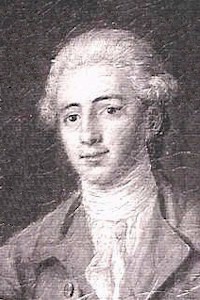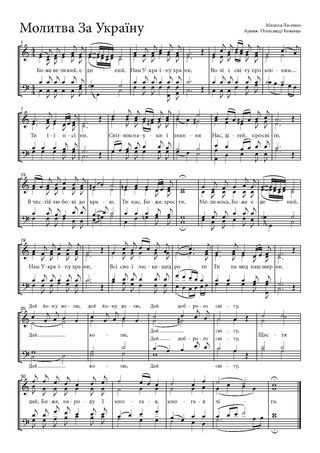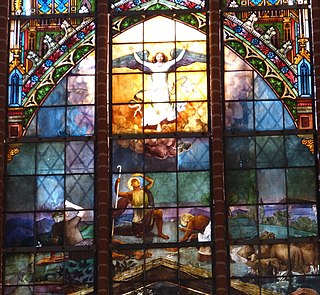Related Research Articles

John Milford Rutter is an English composer, conductor, editor, arranger, and record producer, mainly of choral music.

Saint Nicolas, Op. 42, is a cantata with music by Benjamin Britten on a text by Eric Crozier, completed in 1948. It covers the legendary life of Saint Nicholas, Bishop of Myra, Lycia, in a dramatic sequence of events. The composer wrote the work for the centenary of Lancing College in Sussex, with the resources of the institution in mind. It is scored for mixed choir, tenor soloist, four boys singers, strings, piano duet, organ and percussion. The only professionals required are the tenor soloist, a string quintet to lead the other strings, and the percussionists. Saint Nicolas is Britten's first work for amateur musicians, and it includes congregational hymns. The premiere was the opening concert of the first Aldeburgh Festival in June 1948, with Peter Pears as the soloist.
John Henry Maunder was an English composer and organist best known for his cantata "Olivet to Calvary".

"Christ the Lord Is Risen Today" is a Christian hymn associated with Easter. Most of the stanzas were written by Charles Wesley, and the hymn appeared under the title "Hymn for Easter Day" in Hymns and Sacred Poems by Charles and John Wesley in 1739. The hymn eventually became well known for the "Alleluia" sung as a melisma after each line, which was added by an unknown author, probably to fit the commonly used hymn tune, "Easter Hymn". It remains a traditional processional hymn on Easter Sunday.
Patrick Larley is a British composer.
"For the Beauty of the Earth" is a Christian hymn by Folliott S. Pierpoint (1835-1917).

"All Hail the Power of Jesus' Name" is a Christian hymn.
A Gaelic Blessing is an English language choral composition by John Rutter, consisting of four vocal parts (SATB) and organ or orchestra. It is also known by the repeating first line of the text, "Deep peace". The work was commissioned by the Chancel Choir of First United Methodist Church, Omaha, Nebraska, for their conductor Mel Olson. It was published first in 1978 by Hinshaw Music, by Oxford University Press and by the Royal School of Church Music.

John Rutter's Gloria is a musical setting of parts of the Latin Gloria. He composed it in 1974 on a commission from Mel Olson, and conducted the premiere in Omaha, Nebraska. He structured the text in three movements and scored it for choir, brass, percussion and organ, with an alternative version for choir and orchestra. It was published in 1976 by Oxford University Press.

The Crucifixion: A Meditation on the Sacred Passion of the Holy Redeemer is an oratorio for a SATB choir and organ composed by John Stainer in 1887, with text by W J Sparrow Simpson. The piece relates the Biblical narrative of the Passion and Crucifixion of Jesus. It is particularly noted for the Christian hymn "All for Jesus, All for Jesus".

Geoffrey Turton Shaw was an English composer and musician specialising in Anglican church music. After Cambridge, where he was an organ scholar, he became a schoolmaster, then a schools inspector, while producing a stream of compositions, arrangements, and published collections of music. He was awarded the Lambeth degree of Doctor of Music.

"Prayer for Ukraine" is a patriotic Ukrainian hymn published in 1885, which became a spiritual anthem of Ukraine. The text was written by Oleksandr Konysky, and the music was composed by Mykola Lysenko, first with a children's choir in mind. The song became the regular closing hymn in services of the Ukrainian Greek Catholic Church, the Orthodox Church of Ukraine and other churches. It gained national significance when it was performed by mass choirs during the Ukrainian War of Independence in 1917–1920. The hymn was intended to be an official spiritual anthem of Ukraine. It has closed sessions of oblast councils, and has been performed at major national functions.

Psalm 50, a Psalm of Asaph, is the 50th psalm from the Book of Psalms in the Bible, beginning in English in the King James Version: "The mighty God, even the LORD, hath spoken, and called the earth from the rising of the sun unto the going down thereof." In the slightly different numbering system used in the Greek Septuagint and Latin Vulgate translations of the Bible, this psalm is Psalm 49. The opening words in Latin are Deus deorum, Dominus, locutus est / et vocavit terram a solis ortu usque ad occasum. The psalm is a prophetic imagining of God's judgment on the Israelites.

Angels' Carol is a popular sacred choral piece by John Rutter for Christmas. He wrote his own text, beginning "Have you heard the sound of the angel voices", three stanzas with the refrain "Gloria in excelsis Deo". It has been part of recordings of collections of Christmas music, including one conducted by the composer.
"The Lord bless you and keep you" is a classical sacred choral composition by Peter Lutkin, later adapted by John Rutter, based on Numbers 6:24-26. It is a setting of a biblical benediction, followed by an extended "Amen". Rutter scored the piece for four vocal parts (SATB) and organ. He composed it in 1981 for the memorial service of Edward T. Chapman, the director of music at Highgate School, London, with whom he had studied when he attended the school.
A Clare Benediction is an anthem by John Rutter, beginning May the Lord show his mercy upon you. Rutter wrote both the text and music of the composition to honour Clare College, Cambridge, where he had studied. The work was published by Oxford University Press in 1998.
"Ye Choirs of New Jerusalem" or "Sing, Choirs of New Jerusalem" is an English Easter hymn by Robert Campbell. It is a 19th-century translation of the medieval Chorus novae Ierusalem, attributed to Fulbert of Chartres. The text's primary focus is the Resurrection of Jesus, taking the theme of Jesus as triumphant victor over death and deliverer of the prisoners from Hell.
A virtual choir, online choir or home choir is a choir whose members do not meet physically but who work together online from separate places. Some choirs just sing for the joy of the shared experience, while others record their parts alone and send their digital recordings, sometimes including video, to be collated into a choral performance. There may be a series of rehearsals which singers can watch online, and their performance recordings may be made while watching a video of the conductor, and in some cases listening to a backing track, to ensure unanimity of timing. The worldwide COVID-19 pandemic in 2020 inspired a large growth in the number of virtual choirs, although the idea was not new.
Daniel Troen Moe was an American choral conductor, composer, and pedagogue. He was director of choral organizations for the University of Iowa, professor of choral conducting at Oberlin College Conservatory of Music, and founding music director of Key Chorale in Sarasota, Florida. He was a published composer and author. He was once hailed by The New Yorker music critic Andrew Porter as "that dean of choral conductors."
"Look at the world" is a sacred choral composition by John Rutter, a harvest anthem to his own words. He offered versions for children's choir in unison or a four-part mixed choir, with keyboard or orchestra. It was commissioned by the Council for the Protection of Rural England. The work was published by Oxford University Press in 1996.
References
- ↑ Vernier, David (6 November 2014). "Rutter: Mass of the Children, etc. / Cambridge Singers". classicstoday.com. Retrieved 15 October 2020.
- ↑ "John Rutter / For the Beauty of the Earth". Oxford University Press. 1978. Retrieved 2 June 2019.
- ↑ "For the Beauty of the Earth". hymnary.org. Retrieved 14 November 2020.
- 1 2 3 Hawn, C. Michael (6 November 2014). "John Rutter (b. 1945) / Psalmfest (1993)". United Methodist Church. Retrieved 15 October 2020.
- 1 2 3 4 5 6 Dickey, Timothy. "John Rutter / For the Beauty of the Earth, for chorus & orchestra". AllMusic . Retrieved 2 June 2019.
- 1 2 3 4 5 "For the beauty of the earth" (PDF). Carus-Verlag. 2015. Retrieved 15 October 2020.
- ↑ Greenshaw, Art (2015). Mesquite. Arcadia Publishing. p. 67. ISBN 978-1-46-713357-9.
- ↑ "The Rosemary Heffley Memorial Scholarship". The Children's Chorus of Greater Dallas. 2019. Retrieved 15 October 2020.
- ↑ "John Rutter / For the beauty of the earth". Oxford University Press. 1980. Retrieved 2 June 2019.
- 1 2 3 4 "(The) John Rutter Christmas Album / Skilfully crafted sweet music, beautifully performed, which will bring much pleasure". Gramophone . December 2012. Retrieved 15 October 2020.
- 1 2 "For the Beauty of the Earth, for chorus & orchestra". AllMusic. 2020. Retrieved 15 October 2020.
- ↑ "How can I keep from singing?". prestomusic.com. Retrieved 15 October 2020.
- ↑ "Sing We Merrily". prestomusic.com. Retrieved 15 October 2020.
- ↑ "New Light New Hope". prestomusic.com. Retrieved 15 October 2020.
- ↑ "Pigs Could Fly". prestomusic.com. Retrieved 15 October 2020.